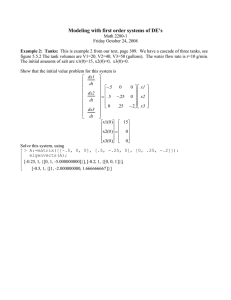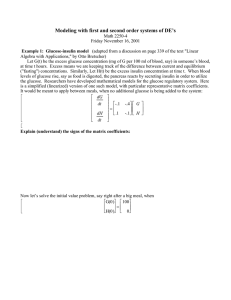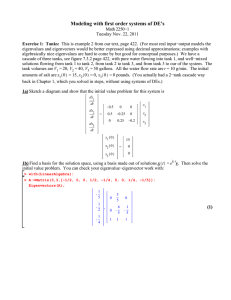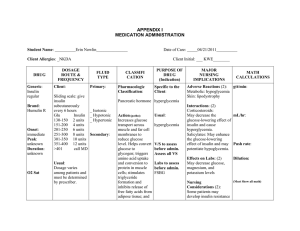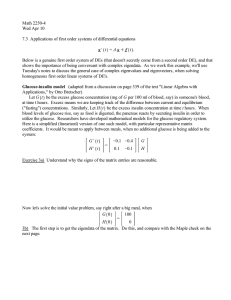Modeling with first order systems of DE’s
advertisement
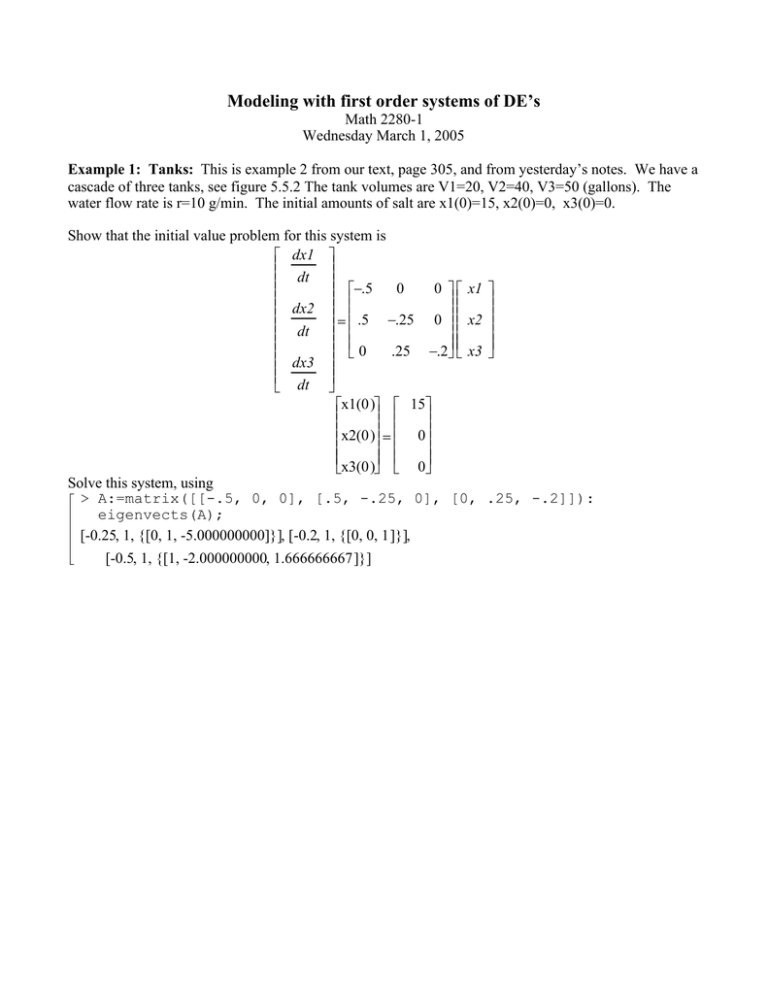
Modeling with first order systems of DE’s
Math 2280-1
Wednesday March 1, 2005
Example 1: Tanks: This is example 2 from our text, page 305, and from yesterday’s notes. We have a
cascade of three tanks, see figure 5.5.2 The tank volumes are V1=20, V2=40, V3=50 (gallons). The
water flow rate is r=10 g/min. The initial amounts of salt are x1(0)=15, x2(0)=0, x3(0)=0.
Show that the initial value problem for this system is
dx1
dt
−.5
0
0 x1
dx2
= .5 −.25 0 x2
dt
.25 −.2 x3
0
dx3
dt
x1(0 ) 15
x2(0 ) = 0
x3(0 ) 0
Solve this system, using
> A:=matrix([[-.5, 0, 0], [.5, -.25, 0], [0, .25, -.2]]):
eigenvects(A);
[-0.25, 1, {[0, 1, -5.000000000]}], [-0.2, 1, {[0, 0, 1 ]}],
[-0.5, 1, {[1, -2.000000000, 1.666666667 ]}]
You should get
x1(t )
3
0
0
( −0.5 t )
( −0.25 t )
( −0.2 t )
x2(t ) = 5 e
-6 + 30 e
1 + 125 e
0
x3(t )
5
-5
1
We can plot the three solute amount vs. time to see what is going on:
> x1:=t->15*exp(-.5*t):
x2:=t->-30*exp(-.5*t)+30*exp(-.25*t):
x3:=t->25*exp(-.5*t)-150*exp(-.25*t)+125*exp(-.2*t):
> plot({x1(t),x2(t),x3(t)},t=0..30,color=black,
title=‘salt contents in each tank‘);
salt contents in each tank
14
12
10
8
6
4
2
0
5
10
15
t
20
25
30
Example 2: Glucose-insulin model (adapted from a discussion on page 340-341 of the text "Linear
Algebra with Applications," by Otto Bretscher)
Let G(t) be the excess glucose concentration (mg of G per 100 ml of blood, say) in someone’s blood,
at time t hours. Excess means we are keeping track of the difference between current and equilibrium
("fasting") concentrations. Similarly, Let H(t) be the excess insulin concentration at time t. When blood
levels of glucose rise, say as food is digested, the pancreas reacts by secreting insulin in order to utilize
the glucose. Researchers have developed mathematical models for the glucose regulatory system. Here
is a simplified (linearized) version of one such model, with particular representative matrix coefficients.
It would be meant to apply between meals, when no additional glucose is being added to the system:
dG
dt −.1 −.4 G
=
dH .1 −.1 H
dt
Explain (understand) the signs of the matrix coefficients:
In Bretscher the topic at hand was discrete dynamical systems rather than continuous ones, and the
model given was:
G(t + 1 ) 0.9 -0.4 G(t )
=
.
H(t + 1 ) 0.1 0.9 H(t )
Explain how I converted this discrete dynamical system into a related first order system of DE’s!
(Notice the matrices are NOT the same!)
Now let’s solve the initial value problem, say right after a big meal, when
G(0 ) 100
=
H(0 ) 0
> restart:with(linalg):with(plots):
> A:=matrix(2,2,[-.1,-.4,.1,-.1]);
-0.1 -0.4
A :=
0.1 -0.1
> eigenvects(A);
[-0.1 − 0.2000000000 I, 1, {[-2.000000000 − 0. I, 0. − 1. I]}],
[-0.1 + 0.2000000000 I, 1, {[-2.000000000 + 0. I, 0. + 1. I]}]
Can you get the same eigenvalues and eigenvectors? Extract a basis for the solution space to his
homogeneous system of differential equations from the eigenvector information above:
Solve the initial value problem.
Here are some pictures to help understand what the model is predicting:
(1) Plots of glucose vs. insulin, at time t hours later:
> G:=t->100*exp(-.1*t)*cos(.2*t):
H:=t->50*exp(-.1*t)*sin(.2*t):
> plot({G(t),H(t)},t=0..30,color=black,title=
‘Excess Glucose and Insulin concentrations‘);
Excess Glucose and Insulin concentrations
100
80
60
40
20
0
5
10
15
t
–20
20
25
30
2) A phase portrait of the glucose-insulin system:
> pict1:=fieldplot([-.1*G-.4*H,.1*G-.1*H],G=-40..100,H=-15..40):
soltn:=plot([G(t),H(t),t=0..30],color=black):
display({pict1,soltn},title=‘Glucose vs Insulin
phase portrait‘);
Glucose vs Insulin
phase portrait
40
30
H
20
10
–40
–20
20
40
60
G
–10
80
100
